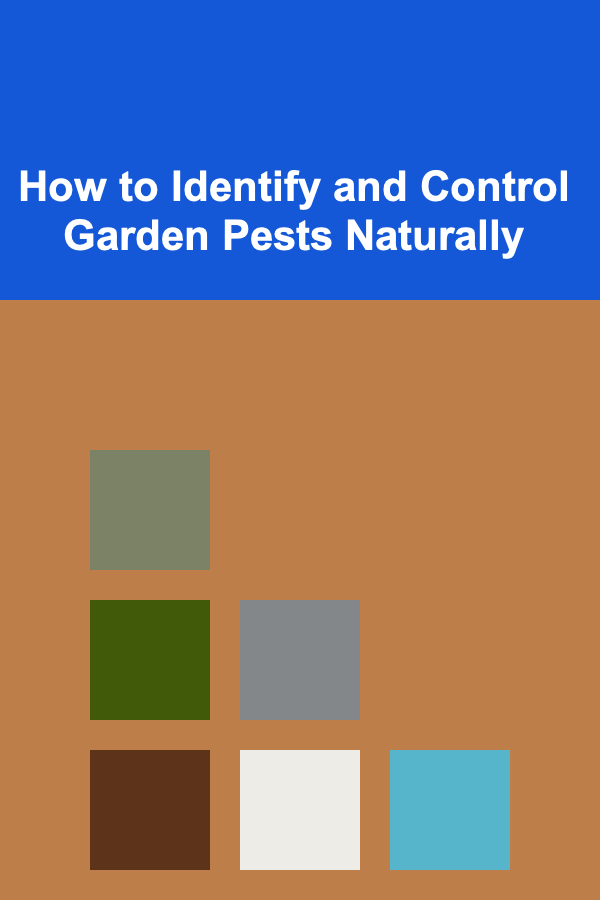
How to Identify and Control Garden Pests Naturally
ebook include PDF & Audio bundle (Micro Guide)
$12.99$7.99
Limited Time Offer! Order within the next:

Gardening is a fulfilling and rewarding hobby, but one of the most significant challenges gardeners face is managing pests. Whether you're growing vegetables, flowers, or ornamental plants, pests can wreak havoc on your garden if not managed properly. While chemical pesticides are a common solution, they can be harmful to the environment, beneficial insects, and even humans. Fortunately, there are numerous natural methods for identifying and controlling garden pests that can help you maintain a healthy, sustainable garden. This article explores how to identify garden pests and implement natural pest control strategies that are safe for your plants, beneficial insects, and the ecosystem.
Understanding Garden Pests
Before diving into natural pest control methods, it's essential to understand what constitutes a garden pest. Garden pests are typically insects, rodents, and even fungi that damage plants by feeding on them, spreading diseases, or competing for resources. While some pests are easy to spot, others may go unnoticed until significant damage has occurred. Identifying the pest is the first step in determining the best course of action for control.
Common Types of Garden Pests
-
Insects: These are the most common pests in gardens, and they can cause damage by feeding on leaves, stems, or roots. Some insects may also carry diseases or lay eggs that hatch into larvae, further damaging the plants.
- Aphids: Small, soft-bodied insects that suck sap from plants, causing curling, yellowing, or wilting of leaves.
- Whiteflies: Small, white, flying insects that feed on plant sap and cause similar damage to aphids.
- Caterpillars: The larvae of moths and butterflies that chew holes in leaves and can quickly defoliate plants.
- Japanese Beetles: These beetles can skeletonize leaves by feeding on the tissue between the veins.
-
Rodents: Mice, rats, squirrels, and rabbits are common garden pests that damage plants by gnawing on stems, roots, or fruits. They may also burrow into the soil and disturb plant roots.
-
Slugs and Snails: These mollusks are known for their slow-moving, slimy trails, and they feed on leaves, stems, and flowers, often leaving large holes or slime trails on the plants.
-
Fungi: Certain fungi can act as pests by infecting plants, causing diseases such as blight, mold, and mildew. Fungal infections can weaken plants and even lead to their death.
-
Nematodes: These microscopic worms feed on plant roots, stunting growth and causing wilting or yellowing of leaves.
Signs of Pest Infestation
Garden pests can be tricky to identify, especially in the early stages of infestation. However, there are several signs that can help you detect a problem before it gets out of hand:
- Discolored or Damaged Leaves: Yellowing, wilting, or browning of leaves could indicate a pest feeding on the plant.
- Chewed or Torn Leaves: Holes or irregularly shaped leaves suggest insects or animals are feeding on your plants.
- Visible Insects: Spotting pests such as aphids, caterpillars, or beetles on the plant is a clear sign of an infestation.
- Sticky Substance on Plants: Aphids and other sap-sucking insects excrete a sticky substance called honeydew, which can attract mold and ants.
- Deformed or Stunted Growth: Pests feeding on plant roots or stems may cause the plant to become stunted, with poor or malformed growth.
- Fungal Growth: Fungal infections are often marked by black or grayish mold on leaves, stems, or fruits.
Natural Pest Control Methods
Once you've identified the pests in your garden, the next step is to implement natural pest control methods that avoid harmful chemicals. Here are some effective and eco-friendly strategies:
1. Encourage Beneficial Insects
One of the best ways to naturally control garden pests is to attract beneficial insects that prey on harmful pests. These insects act as natural predators and help keep pest populations in check.
- Ladybugs: Ladybugs are voracious eaters of aphids and other small pests. You can attract ladybugs by planting flowers such as daisies, marigolds, or yarrow.
- Lacewings: Lacewing larvae feed on aphids, mealybugs, and scale insects. To attract lacewings, plant dill, fennel, or coriander in your garden.
- Predatory Mites: These tiny mites are effective at controlling spider mites, thrips, and other small pests. Introduce them into your garden to help reduce pest populations.
2. Companion Planting
Companion planting involves growing certain plants together to help repel pests or attract beneficial insects. Some plants naturally repel insects with their strong smells or chemicals, while others attract predators that feed on pests.
- Marigolds: Known for their strong scent, marigolds can help repel aphids, whiteflies, and nematodes.
- Garlic and Chives: These plants can deter aphids, Japanese beetles, and other pests.
- Basil: Basil can help repel mosquitoes, flies, and aphids when planted near tomatoes, peppers, and other vegetables.
- Nasturtiums: These colorful flowers attract aphids and other pests, diverting them from other plants in your garden.
3. Use Diatomaceous Earth
Diatomaceous earth (DE) is a naturally occurring, abrasive substance made from the fossilized remains of diatoms. It can be sprinkled around plants or directly onto pests, where it causes them to dehydrate and die. DE is particularly effective against soft-bodied insects like slugs, snails, and aphids.
- How to Use: Sprinkle a thin layer of diatomaceous earth around the base of plants or on leaves where pests are present. Reapply after rain or watering.
4. Neem Oil
Neem oil is a natural insecticide derived from the seeds of the neem tree. It contains compounds that disrupt the reproductive and feeding behaviors of insects, making it an effective tool for controlling a wide range of garden pests.
- How to Use: Mix neem oil with water according to the instructions on the label and spray it directly onto plants, focusing on the undersides of leaves where pests often hide. Neem oil works best when applied in the early morning or late afternoon.
5. Soap and Water Spray
A simple and effective natural pest control method is a soap and water solution. This mixture can be used to kill soft-bodied insects like aphids, whiteflies, and mealybugs by suffocating them.
- How to Use: Mix a mild liquid soap (such as castile soap) with water in a spray bottle. Spray the solution onto the affected areas of your plants, ensuring that you cover the undersides of leaves where pests are often hiding. Avoid using harsh soaps, as they can damage plants.
6. Hand-Picking and Traps
For smaller infestations, manual removal of pests can be an effective way to control them without the use of chemicals. Hand-picking involves physically removing pests from your plants and either relocating them or squishing them.
- How to Use: Check plants regularly for pests, especially on the undersides of leaves and in flower buds. Gently remove any visible pests and drop them into a container of soapy water to kill them.
- Traps: Sticky traps can be placed near plants to capture flying insects like whiteflies and aphids. You can also create homemade traps using beer to attract and trap slugs and snails.
7. Crop Rotation
Crop rotation involves planting different types of crops in different locations each season to prevent pests from becoming established. Many pests are host-specific, meaning they tend to target specific plants. By rotating crops, you can disrupt their life cycle and reduce the likelihood of pest infestations.
- How to Use: Plan your garden so that you rotate crops each season. For example, if you planted tomatoes in one area last season, move them to a different spot the following season.
8. Garlic and Pepper Spray
Garlic and hot pepper spray is a natural deterrent for many garden pests, including aphids, mosquitoes, and rabbits. The strong smell and heat of garlic and peppers repel pests and can be an effective way to protect plants.
- How to Use: Blend garlic and hot peppers with water, strain the mixture, and pour it into a spray bottle. Spray it onto plants, focusing on areas where pests are most active.
9. Introduce Natural Predators
In some cases, you can introduce natural predators to your garden to help keep pest populations in check. For example, introducing ducks or chickens to your garden can help control slugs, snails, and weeds. These animals are natural foragers that can eat a variety of pests without harming your plants.
- How to Use: If appropriate for your garden, consider allowing ducks or chickens to roam freely or set up a designated area for them to forage.
10. Maintaining Garden Health
A healthy garden is less susceptible to pests. Healthy plants are better able to withstand damage from pests, and a balanced ecosystem can naturally regulate pest populations. Practice good gardening practices such as proper watering, soil maintenance, and plant care to keep your garden in optimal condition.
- How to Use: Ensure your plants are getting the right amount of water, sunlight, and nutrients. Mulch around plants to retain moisture and prevent weed growth. Regularly check for signs of pests and remove them early.
Conclusion
Controlling garden pests naturally requires a combination of vigilance, knowledge, and sustainable practices. By identifying pests early, encouraging beneficial insects, using natural remedies, and maintaining healthy garden practices, you can protect your plants without harming the environment or your health. Implementing these natural pest control methods will not only help you manage pests but also create a thriving, biodiverse garden that benefits the ecosystem. Whether you're a seasoned gardener or a beginner, the key to success lies in fostering balance and harmony in your garden.

Becoming a Mobile App Developer: Key Strategies for Success in the App Industry
Read More
How to Clean Your Windows and Keep Them Sparkling
Read More
How to Make Your Own Pet-safe Cleaning Products for Your Home
Read More
How to Save Money When Cutting Down on Wedding Guest Expenses
Read More
How to Use Clear Containers for Essential Oil Visibility
Read More
How to Use Motion Detectors to Alert You of Intruders
Read MoreOther Products

Becoming a Mobile App Developer: Key Strategies for Success in the App Industry
Read More
How to Clean Your Windows and Keep Them Sparkling
Read More
How to Make Your Own Pet-safe Cleaning Products for Your Home
Read More
How to Save Money When Cutting Down on Wedding Guest Expenses
Read More
How to Use Clear Containers for Essential Oil Visibility
Read More